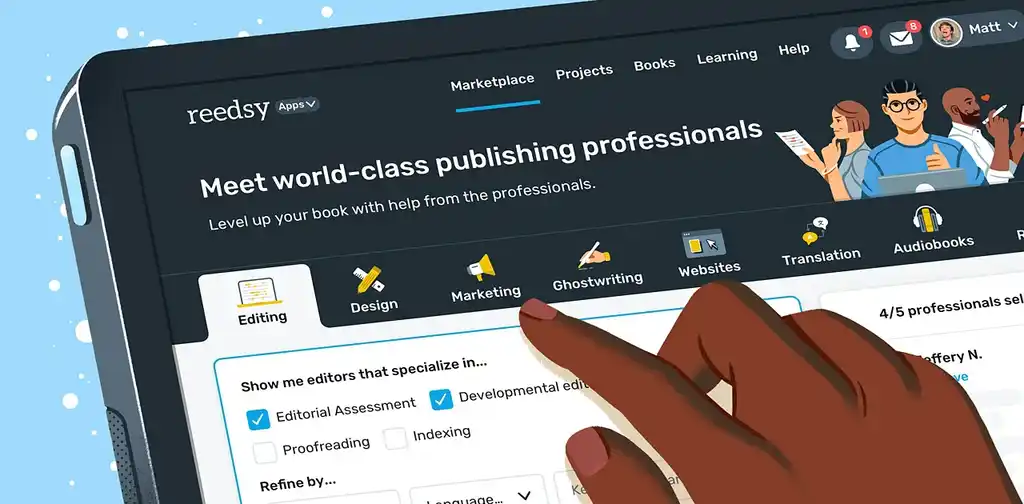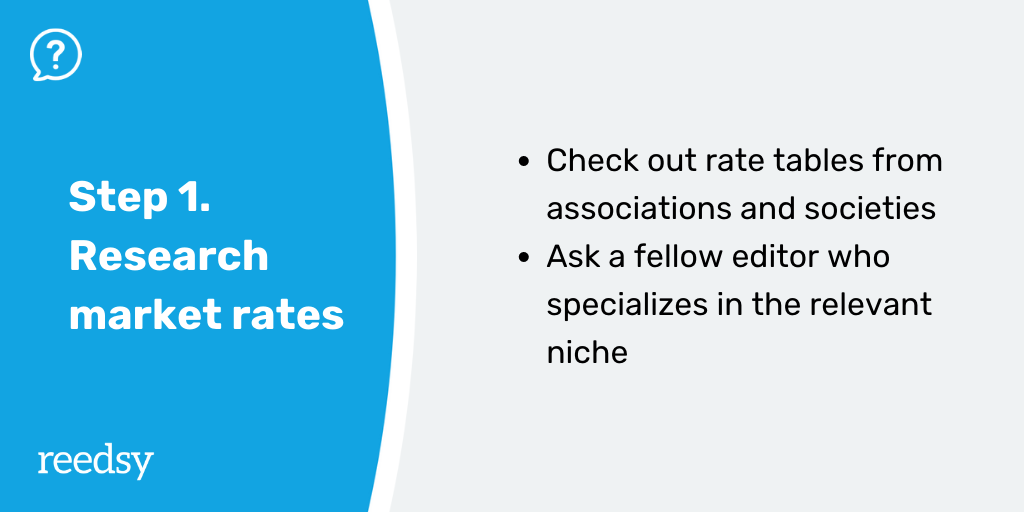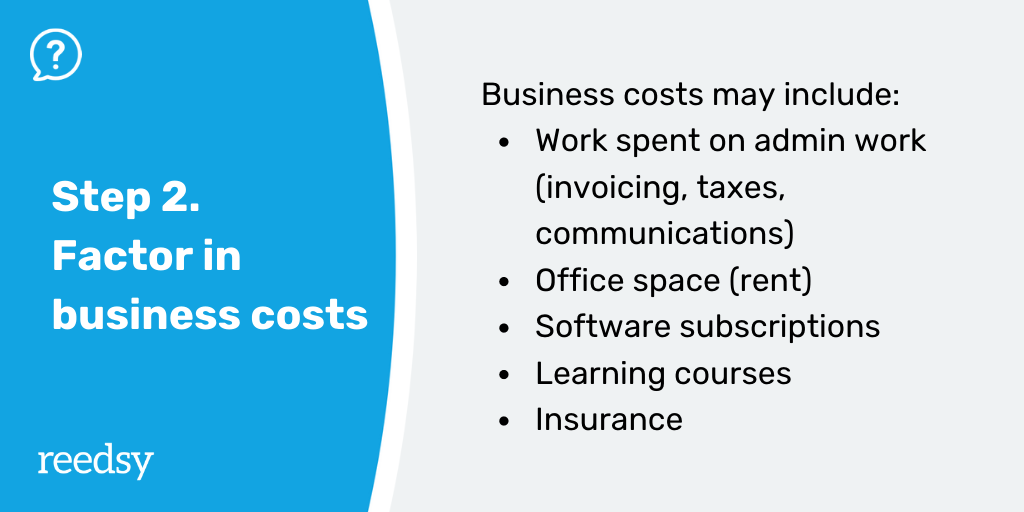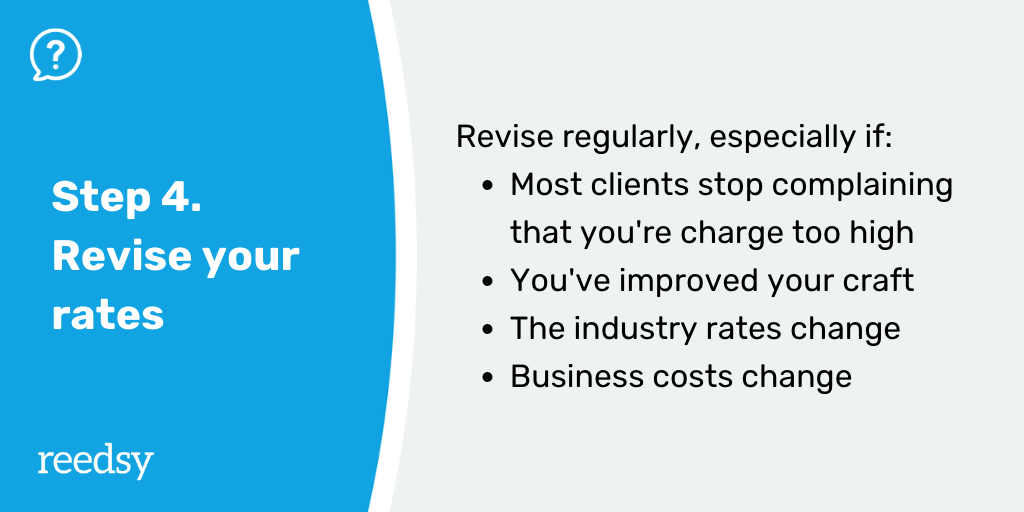Blog •
Last updated on Feb 13, 2025
How to Set Your Freelance Editing Rates
Ricardo Fayet
Reedsy co-founder and Chief Marketing Officer, Ricardo Fayet has worked with hundreds of authors on their launches and marketing campaigns. He is the author of two bestselling guides on marketing for authors, and a regular presenter at the largest writers' conferences.
View profile →Linnea Gradin
The editor-in-chief of the Reedsy Freelancer blog, Linnea is a writer and marketer with a degree from the University of Cambridge. Her focus is to provide aspiring editors and book designers with the resources to further their careers.
View profile →This article was written based on insights from Reedsy Marketplace and in collaboration with professional freelance editors Maria D’Marco, Andrew Lowe, Lisa Howard, Christina Roth, Laura Mae Isaacman, Ameesha Green, and Perrin Davies.
Perhaps the biggest question facing editors on the cusp of leaving the security of in-house employment is how to set their freelance editing rates. On the surface it might seem simple: just charge what a publisher was willing to pay you — isn’t that the value the market has placed on you?
Well, just using your in-house rate may not be a great idea. The freelance market is a completely different beast, and you might be way off. Indie clients tend to have a smaller budget than publishers, so you don’t want a high asking price, but you don’t want to lose out on potential earnings either. On top of all of that, you now have to factor in the time and cost of being your own employer. But worry not, we’ve compiled the average freelance rates set by professionals on the Reedsy network along with their personal tips on setting your freelance editor rates.
Average freelance editing rates
Based on 2024 data from Reedsy's marketplace, average freelance editor rates can fall between $0.020 per word for proofreading, $0.023 for an editorial assessment, $0.024 for copy editing, and $0.032 for developmental editing. For combined copy editing and proofreading, Reedsy freelancers charge $0.025 per word, on average.
All that said, most editors prefer to charge per word, since hourly rates don't account for the fact that the more skilled you are, the faster you can get the job done. Some editors also charge per page, with rates falling somewhere between $5 to $10 per page.
Note that at Reedsy, we do not distinguish between line editing and copy editing, though rates for line editing typically fall between $0.04 to $0.06 per word.
If this is all sounding a bit like a math-lesson, here is summary table for you to consult:
|
Service |
Per-word rate |
Per-hour rate |
|
Editorial Assessment |
$0.023 |
N/A |
|
Content / Developmental Editing |
$0.032 |
$45-$66/hour |
|
Copy Editing |
$0.025 |
$35-$55/hour |
|
Proofreading |
$0.020 |
$30-$45/hour |
|
Copy Editing + Proofreading |
$0.025 |
N/A |
⚠️Note that many editors can (and do) charge higher rates than these, taking their years of experience and market demand into account. One good way to find your own, ideal rate is to gradually increase it every few months until you find that you've hit a ceiling.
Within each of these editorial types (copy editing, proofreading, etc.) there will also be a range of baseline fees determined by:
- The freelancer’s experience and portfolio
- Where the freelancer is located in the world
- What genre(s) they specialize in.
“I primarily edit fiction, but also do and have done extensive work with self-help books,” says editor Maria D’Marco. “I charge differently for this type of book because the content must be deeply edited for comprehension, consistency, and logic path — yet I must also maintain the writer's voice and aesthetics.”
Using data pulled from thousands of recent quotes from the Reedsy marketplace, we’ve put together a whole selection of average rates per genre for three of the major editing services.
🍼 If you’re editing picture books or poetry, these by-word rates will not apply as there are many other aspects involved that you will have to take into account, from your level of experience, to time spent, and the value you bring to the collaboration.
Content/Developmental Editing Rates
The average freelance development editing rates are as follows:
|
Genre |
Average Editing Rate per Word |
|
Romance |
$0.023 |
|
Thriller, Crime, Mystery |
$0.029 |
|
Sci-Fi and Fantasy |
$0.032 |
|
YA |
$0.030 |
|
Historical Fiction |
$0.030 |
|
Literary Fiction |
$0.029 |
|
Children's Middle Grade |
$0.031 |
|
Memoir |
$0.035 |
|
Nonfiction (Business, Self-Help, etc.) |
$0.042 |
Copy Editing Rates
The average freelance copy editing rates are as follows:
|
Genre |
Average Editing Rate per Word |
|
Romance |
$0.020 |
|
Thriller, Crime, Mystery |
$0.023 |
|
Sci-Fi and Fantasy |
$0.022 |
|
YA |
$0.023 |
|
Historical Fiction |
$0.021 |
|
Literary Fiction |
$0.024 |
|
Children's Middle Grade |
$0.024 |
|
Biographies & Memoirs |
$0.025 |
|
Nonfiction (Business, Self-Help, etc.) |
$0.029 |
Proofreading Rates
The average freelance proofreading rates are as follows:
|
Genre |
Average Editing Rate per Word |
|
Romance |
$0.015 |
|
Thriller, Crime, Mystery |
$0.017 |
|
Sci-Fi and Fantasy |
$0.017 |
|
YA |
$0.016 |
|
Historical Fiction |
$0.015 |
|
Literary Fiction |
$0.018 |
|
Children's Middle Grade |
$0.018 |
|
Biographies & Memoirs |
$0.018 |
|
Nonfiction (Business, Self-Help, etc.) |
$0.020 |
Now, you might feel as if you’ve just watched a round of Numberwang but don’t worry — these are merely references for baseline rates. To set freelance editing rates that really do justice to your hard work, follow the five steps below, as advised by some of Reedsy’s most experienced freelance editors.

JOIN OUR NETWORK
Supercharge your freelance career
Find projects, set your own rates, and get free resources for growing your business.
How to set your freelance editor rates in 5 steps
Step 1: Research the market
Freelancers are, essentially, entrepreneurs. And, as any good entrepreneur can tell you, the first thing you need to do is understand your market and see where you might fit in.

Check out online resources 🌐
Other than the details that we’ve given you so far, you can check out the resources of other editing societies and associations. The Editorial Freelancers Association has a page that lays out a range of rates for each particular service, so if you’re wondering, “What do freelance editors charge per hour?”, hourly editing rate tends to fall between $35-$65/hour, according to the EFA.
At Reedsy, we advise charging per word rather than per hour. Why? Well, because every editor works a little differently, and the hourly rates pertains more to speed than quality. The per-word rate is a more accurate reflection of your abilities and hard work, and also offers greater transparency for your clients.
Ask your peers 👩💼
There’s no need to be cloak and dagger in your market research. Editor Andrew Lowe suggests simply asking your fellow editors how much they charge — either online or in person. “They’re usually friendly and willing to help. Try to assess how long they’ve been in the game and adjust your rates accordingly.”
Step 2: Factor in your business costs
Here’s a mistake that’s all too common for first-time freelancers: you set your rate, get as much work as you can handle, and at the end of the year, you still discover red ink in your ledger. The root cause? Neglecting your business costs.
Working in-house has a lot of perks that will disappear as soon as you become your own boss. Some of the things you’ll need to account for when putting together your business plan include:
- Non-billable time spent on admin work (you can track this with a time tracker);
- Your workspace, software, and materials;
- Time spent developing your skills and learning new techniques; and
- Insurance.
When deciding what editing rate to charge, you should figure out how much money you need to make to cover these costs and sustain your as well as your family’s livelihood. For the longer term, you’ll even want to make enough to save a portion for when business is sparse (which inevitably will happen when you freelance). Professionals become self-emlpoyed for the freedom that job offers, not because they enjoy defaulting on their mortgage: make sure your rate allows you to meet your personal needs and that you have a safety net.
Personal expenses will differ depending on where you live. The cost of living in New York is higher than say, Kansas, and it’s perfectly alright for editors who live in the former to charge a higher rate to reflect that.

With the market research and the cost analysis done, you’ve basically nailed down your base rate — i.e., the minimum rate that you’d expect. Next, we’ll see how you should go about adjusting this to suit each project.
Step 3: Adjust your rate to the needs of each project
Before you start quoting your base rate to each and every potential client that crosses your inbox, ask yourself the following questions.

What stage is the book at? 📍
The ‘maturity’ of a manuscript will vary from one project to another — especially with independent authors — and have a big impact on the time you spend on it. In the early stages of communicating with a potential client, you may have to adjust their perceptions.
Andrew Lowe suggests approaching ‘immature’ manuscripts with great caution: “Don’t take on work that clearly hasn’t been redrafted or just isn’t ready yet for editing. It’ll be a miserable few weeks of rewriting when you should be polishing and enhancing — and you’ll feel like you should have charged twice the fee.”
If an author comes to you for a copy edit, but the writing sample clearly suggests more structural work is needed, reach out and communicate your thoughts on the right editing service for them. If you're able to provide said service, offer to do it at a higher price to account for the extra work.
How long will it take to edit or manage? ⌚
If you’re looking to make the jump from in-house to freelance, you probably have a solid understanding of how long it takes to edit a manuscript. But moving into freelance might also mean expanding your scope to more diverse projects, and while we recommend not charging an hourly rate, we also recommend keeping an eye out for extraordinary project deliverables. For instance, if you specialize in memoir editing for entrepreneurs, with every editing gig you get, you’ll probably have to get to know the author a little and research the industry they work in. Your rate could account for this.
Does it need more than just a standard edit? 🧠
Non-fiction developmental and copy editor Lisa Howard suggests adjusting your rate if the job involves specific formatting requirements.
“If the material falls into a “specialty” category, then a certain editorial expertise is needed, meaning the writer can expect to pay more for that expertise. Examples would include cookbook editing (recipe formatting is entirely different from standard editing) or an academic work (again, those require nonstandard formatting knowledge).”
Step 4: Revise your baseline rate every six months
At this point, you should have an idea of how much you will be asking potential clients for in the coming months. However, this number isn’t set in stone. It’s worth remembering that no-one’s going to pay you more than you ask, so you have to know when it’s time to up your rate.
Based on interviews with freelance editors, here are some solid signs that you might need to update your base rate.

When authors stop wrestling with your quote
If you’ve ever been to a Moroccan street market and tried haggling with a merchant, you might understand how awful it feels to have them accept your first offer. The same principle applies to freelance work, according to editor Christina Roth.
“When authors accept my proposals without questioning my fees — or when the authors who decline my proposals stop saying it’s because my fees are too high — I know I’m charging a reasonable (or too reasonable) a fee.”
It might be a good idea to revise your editing fee upward a little after getting a few easy-going clients!
When you get better at your job
Laura Mae Isaacman suggests:
“It's usually time to revisit your rates when your expertise is noticeable. If you're getting better at your job, your rates should reflect that. Revisit your skills every six to nine months, just like you would if you worked for a company.”
This requires a high level of self-awareness — try to pay attention to mistakes as you go, and recall how often you needed to verify them using a style guide or by consulting with other editors. Gather feedback from authors themselves as well — you might notice that you’ve earned more positive ones in the last few months! Little signs like that could be an indication that you should check your prices again.
When broader industry rates change
“I tend to do an annual review, almost like an appraisal process,” says editor Ameesha Green. “I recheck the rates across the industry and factor in the experience I’ve gained that year to decide on my pricing for that year."
In other words, Step #1 is something you will want to repeat at regular intervals.
When you’re struggling to cover your business costs
“Everything you do costs more each year.” Maria D’Marco warns. Remember that with inflation, living and business costs go up each year. By not upping your prices, you will effectively make less.
“Do not expect repeat clients to accept this as a reason — if you need to, show them how the extra costs you incurred have helped them and their projects.”
As you increase your rates — whether it’s in line with your experience, inflation, or industry trends — editor Perrin Davies suggests emphasizing the value you bring to the project in your freelance proposal. “I always supply the edited sample to the potential client with the quote so we're both confident that my approach meets the client's needs and so the value proposition is evident.”
And there you have it. While this four-step process isn’t the only way for you to determine what you charge for your editorial work, it hopefully provides you with the necessary information to make the best decision.

FREE RESOURCE
Invoice Template
Provide billing and payment details with this professional template.
